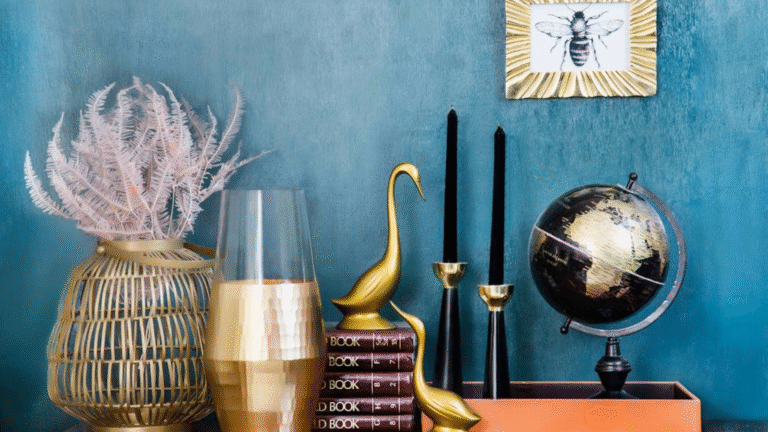Cheap Home Decor: How To Decorate Your Home on a Budget
I’ve always believed a beautiful home isn’t about money — it’s about intention. My first apartment had mismatched chairs, a chipped coffee table, and a secondhand sofa that squeaked every time someone sat down. Yet somehow, that little space felt good to walk into. It was mine, and that made all the difference.
Years later, after decorating multiple homes and helping others do the same, I’ve learned that most stylish spaces start the same way: with creativity, not credit cards.
According to the 2024 Opendoor Home Decor Report, Americans spend an average of $1,598 each year on décor and another $5,635 on renovations. That’s a lot of money for comfort and style — and it shows we care deeply about our spaces. But I’ve also seen how a bit of smart planning and resourcefulness can stretch a fraction of that budget a long way.
Begin With What You Already Own
When I’m helping friends decorate, the first thing I tell them is, “Shop your house.” You’d be surprised how many hidden treasures are already sitting in plain sight.
That forgotten lamp in the attic might look new again with a fresh shade. A runner rug can bring warmth to a hallway. I once pulled an old mirror from a guest room closet, repainted the frame black, and hung it in the living room — it instantly became a statement piece.
Rearranging furniture or moving pieces between rooms can transform a space overnight. These small swaps cost nothing but give the house a new rhythm.
The Real Reason DIY Keeps Growing
DIY used to be a necessity for me — now it’s almost therapy. The satisfaction of sanding down a thrifted table or repainting kitchen cabinets is unmatched. Apparently, I’m not alone: the U.S. Census Bureau says homeowners completed over 50 million DIY projects last year, spending $125 billion total.
Most people (about 75 percent) say they do it to save money. I agree, but for me, it’s more than that. DIY brings personality into a room. A handmade shelf or a repurposed trunk tells a story — one that no showroom can replicate.
And here’s a truth I’ve learned from experience: perfection is overrated. A few uneven paint strokes or visible brush lines often add character, not flaws.
Secondhand Is the New Luxury
I started thrifting long before it became trendy. Today, it’s practically mainstream. The global secondhand furniture market is valued at $34 billion and expected to hit $56 billion by 2030, driven largely by younger, sustainability-minded buyers.
There’s something satisfying about finding a solid wood dresser for $40 and giving it a second life. I’ve refurbished enough furniture to know that good bones matter more than brand labels. A light sanding, fresh paint, and new hardware can make an old piece look boutique-level.
When clients or friends ask where I find my best pieces, I always say the same thing — “Everywhere.” Thrift stores, estate sales, and even curbside finds can surprise you. The trick is patience and vision: don’t buy what’s perfect, buy what has potential.
Paint Changes Everything
If I could only give one piece of advice, it would be this: paint is the cheapest magic in home design. The right color can change how a room feels before you even add a single new item.
About 60 percent of homeowners say a fresh coat of paint is their favorite way to update décor, and I’m one of them. I’ve used warm whites to open up dark corners, deep blues to ground airy rooms, and soft greens to calm small spaces.
I remember painting my dining chairs a muted olive once — instantly, the entire room looked coordinated. For under $40, that project felt like I’d just redecorated an entire home.
Sustainability Makes Style Last
Over time, I’ve grown to see sustainability not as a buzzword but as a mindset. Americans say they’re willing to pay about 11 percent more for sustainable products, but I’ve found that being eco-friendly can actually save money.
Thirty-five percent of people now refinish or repaint what they already own instead of buying new — I’ve done this countless times. A thrifted table with new stain, or old kitchen handles polished to shine, not only saves money but also adds authenticity.
And let’s be honest — the charm of a home often comes from its imperfections, the layers of reuse and reimagining that make it uniquely yours.
Spend Smart, Not Big
If you can afford to splurge, spend it wisely. I always tell readers and clients the same thing: buy fewer, better pieces. In my own home, I saved for a chandelier that became the centerpiece of my dining room. Everything else in the room was budget-friendly — thrifted, DIY’d, or simply refreshed. But that one investment tied everything together.
You don’t need many statement pieces, just the right ones. The rest of your décor can be humble as long as it feels cohesive.
That cohesion comes from restraint — uncluttered surfaces, repeated textures, and a color palette that makes sense. A calm home always looks more expensive than a cluttered one, regardless of budget.
The Online Advantage
I’ve spent hours scrolling through online stores comparing prices, and honestly, it’s one of the best tools for decorating on a budget. More than 55 percent of shoppers say price is their top reason for buying décor online, and they’re right — deals are everywhere.
I’ve scored rugs, curtains, and light fixtures online at half the cost of local stores. My rule is simple: never rush. Watch prices for a week or two, use alerts for discounts, and check resale sites before paying retail.
The art of budget decorating isn’t about doing everything at once — it’s about building thoughtfully over time.
Final Thought
If you walked into my home today, you wouldn’t guess how little I’ve spent on most of it. Every corner has a mix of old and new, thrifted and found, handmade and gifted. It’s proof that warmth and character don’t come from money; they come from care.
Home décor isn’t about chasing trends or matching catalogs. It’s about creating a space that tells your story — one layer, one paintbrush stroke, one budget hack at a time.
And that’s the kind of design that never goes out of style.








